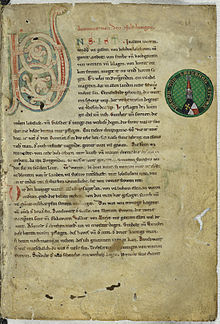Donaueschingen manuscript of the Nibelungs C

The Donaueschinger Nibelungenhandschrift is one of the three most important traditions of the Nibelungenlied and is also referred to as Nibelungenhandschrift C for short in German research . It originated in the second quarter of the 13th century in the Alemannic - Bavarian area, South Tyrol or Vorarlberg are suspected . The writing language of the text also shows clear characteristics that indicate this area.
History and provenance
The parchment manuscript was rediscovered on June 29, 1755 in the library in the Hohenems Palace by the doctor Jacob Hermann Obereit following advice from Johann Jakob Bodmer . The latter published several extracts from it for the first time in 1757. After the manuscript B was found in 1769 and the Hohenems-Munich manuscript A in 1779 , now known as handwriting A , the Zurich-born Christoph Heinrich Myller published a complete edition of the text for the first time in 1782.
Both manuscripts, along with other objects, were inherited in 1803 by the granddaughter of the last Count of Ems, Maria Walburga von Hohenems in Bistrau . In 1807 she gave the two manuscripts to her lawyer Dr. Cobbler from Prague ; the younger manuscript A ended up in the royal court library in Munich , today the Bavarian State Library , where it is still located.
Schuster sold the manuscript C to a dealer named Frickert during the Congress of Vienna, and he asked for 1000 guilders for it. Several interested parties, such as the Austrian Emperor Franz Joseph , George Spencer, 4th Duke of Marlborough and others, tried to acquire it, as did Baron Joseph von Laßberg , who had previously tried in vain to get possession of the manuscript. He finally succeeded in doing this with the help of his patroness, Princess Elisabeth zu Fürstenberg . In 1853 the Fürstliche Hofkammer Donaueschingen acquired Laßberg's library together with the manuscript C. After Laßberg's death in 1855, it was added to the Donaueschingen court library .
In 1999 the manuscript by Joachim Egon Fürst zu Fürstenberg was offered for sale to the state of Baden-Württemberg for 25 million DM. Since 2001 it has been located in Karlsruhe in the Badische Landesbibliothek under the signature Codex Donaueschingen 63 .
Together with the manuscripts A and B, it has been a UNESCO World Heritage Site since 2009 .
Text sample
The handwriting C begins in the non-standardized original spelling as follows:
- Aventure from the Nibelungs
-
U n s i s t in ancient tales. miraculous aside.
-
by heleden lobebæren. of great work.
-
of joy and excitement from crying and complaining.
-
arguing about kuner recken. muget ir now hear miracles say.
-
Ez whs in Bur e gonden. a vil noble magedin.
-
daz in all lands. not nice mohte sin.
-
Chriemhilt heated. dio was a nice wip.
-
dar umbe mosin degene. vil left the lip.
The words have stem vowels throughout . In the place where the scribe once forgot this, at the word Bur e gonden , he wrote it over the corresponding passage to correct it. (see picture above)
Individual evidence
literature
- The Nibelunge Liet - Diu Lament . The Donaueschinger Manuscript 63 [Laßberg 174] with a research-historical contribution on its importance for the transmission and text history of the epic published by Werner Schröder, Böhlau Verlag Cologne - Vienna, 1969
- Eberhard Thiefenthaler: The finding of the manuscript of the Nibelungenlied in Hohenems. In: Montfort . Volume 31, 1979, ISSN 0027-0148 , pp. 295-306 ( [1] ).
- Nibelungen Manuscript C - Donaueschingen 63. ( digitized in the digital collections of the Badische Landesbibliothek )
Web links
- Nibelungen Manuscript C - Donaueschingen 63rd Badische Landesbibliothek Karlsruhe, April 4, 2019(Original: manuscript on parchment, digitized).
- Marburg Repertory: Cod.Donaueschingen 63
